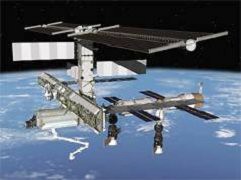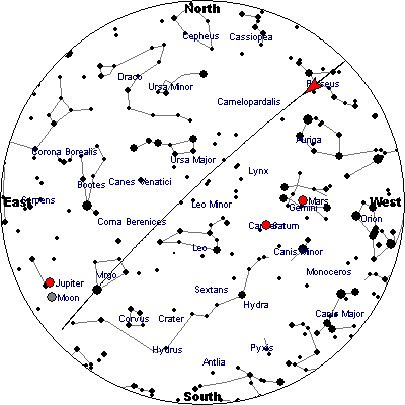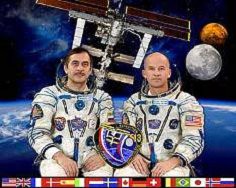9:53 AM
SPACE NEWS visible pass for the DC area
Mister Nizz

Break out your telescopes
SPACE STATION FLYBY: NORTHERN VA, DC and MARYLAND
Every once in a while I get an email from Jeff Barker at Fort Leavenworth, KS, with instructions for viewing the International Space Station as it does a flyby. I've seen it about a half dozen times, thanks to his efforts. If you want to sign up for notification, contact information is in the final paragraph.
Here's today's mission broadcast from Jeff

The Shuttle Discovery is scheduled to launch from Cape Canaveral, FL, at 1549 hours (3:49 p.m.) EST on STS 121. If the launch takes place as scheduled, Discovery will link up with the International Space Station on July 4th.The Shuttle Discovery, joined to the International Space Station, will make a visible pass over the Northern VA/Washington area on Tuesday, 4 July, starting at about 2135. If the Shuttle does not launch on schedule, then the International Station will make the visible pass by itself. See the attached PowerPoint slides for viewing times and a sky map of the pass.
Please READ THE INSTRUCTIONS on the slide to properly orient the sky map. Viewing times are accurate for a radius of about 50 miles. The ISS passes within view of your area occur frequently but most passes are in the middle of the night when the ISS is in the Earth's shadow or during the day when the sky is too bright. Visible passes occur when the ground observer is in darkness yet the satellite is illuminated by the sun. This occurs if the satellite passes within view just before sunrise or just after sunset. Most visible passes are low on the horizon and, therefore, difficult to see.

Generally,I only send out viewing information for high elevation passes. When a visible pass occurs, the ISS can be seen with the naked eye because it is in low earth orbit and it reflects a lot of sunlight because it is so large. Weight: 404,069 pounds. Habitable Volume: 15,000 cubic feet Dimensions: Width Across Solar Arrays: 240 feetLength: 146 feet from Destiny Lab to Zvezda; (171 feet with a Progress docked) Height: 90 feet

Flight Engineer Jeff Williams and Commander Pavel Vinogradov continue preparing the station for its rendezvous and docking with space shuttle Discovery on mission STS-121. The two crew members have checked out the robotic arm, serviced U.S. spacesuits and configured communication headsets. Discovery will bring equipment and supplies to the station.
NASA Science Officer Jeffrey Williams is a Colonel in the U.S. Army. Williams was born, January 18, 1958. He graduated High School in 1976; earned a B.S. from the U.S. Military Academy (USMA) in 1980, an M.S. degree in aeronautical engineering and the degree of aeronautical engineer from the U.S. Naval Postgraduate School, both in 1987, and a master of arts degree in National security and strategic studies from the U.S. Naval War College in 1996.The crew of the Shuttle Discovery are: Steven W. Lindsey, commander; Mark E. Kelly, pilot; Stephanie D. Wilson, Michael E. Fossum, both mission specialists; Piers J. Sellers, mission specialist; European Space Agency (ESA) astronaut Thomas Reiter of Germany; and Lisa M. Nowak, both mission specialists.

The crew of space shuttle Discovery will test new equipment and procedures that increase the safety of space shuttles during the STS-121 mission to the International Space Station. It also will perform maintenance on the space station and deliver more supplies and cargo for future station expansion. This mission is to carry on analysis of safety improvements that debuted on the Return to Flight mission, STS-114, and build upon those tests. Discovery will carry the Italian-built Multi-Purpose Logistics Module (MPLM) Leonardo, with more than two tons of equipment and supplies aboard. A full press kit with detailed information about the shuttle crew and mission STS 121 is available at: +
http://www.nasa.gov/pdf/149873main_sts121_press_kit.pdf
If this message was forwarded to you and you would like to subscribe to future visible passes of the ISS and the Shuttle, send an e-mail to: jefferson.barker@us.army.mil.
Be sure to mention what city you live in since I send out visible pass information for many locations around the country.Jeff Barker(ARINC Engineering Services) US Army Battle Command Battle LabFort Leavenworth, KS